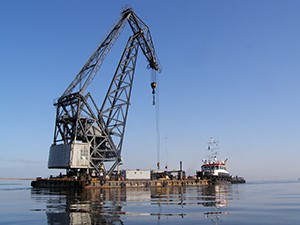Effective Ways to Reduce Deck Barge Equipment and Machine Hazards

There are roughly 4,000 operational deck barges in the United States which use a variety of cranes, winches, and other equipment. Employees on these vessels may face several dangers, including caught by and struck by accidents that can occur due to the types of equipment and machines used on deck barges.
Hazards from moving equipment and machines can cause injuries to workers' feet, hands, or limbs if they become caught. Other potential dangers include falling off equipment or the barge, receiving an electrical shock, drowning, and getting trapped under a load.
How to reduce equipment and machine hazards
Before it is used, inspect the equipment and continue to properly maintain machinery. Make sure the power source is shut down or locked out before completing repairs on equipment. Follow all manufacturer's guidelines when performing maintenance, and train workers completing this task.
Installing temporary or permanent rails help prevent workers and equipment from falling off a barge or dock. Properly install retaining pins with a keeper or locking device to ensure that they will stay in place. Emergency shut-offs should be easily accessible, and employers can better control equipment by installing adequate safeguards. It's also important to keep life preservers readily accessible.
Tips for managing cranes, derricks, and hoists
Crane, derrick, and hoist hazards can arise when heavy objects are moved, and there are numerous ways employers can help reduce workers' risks.
Stay clear when a hoist is being used. Workers who are providing assistance with the hoist should never stand directly under a load or boom with a suspended load.
Personalprotective equipment (PPE) is necessary to protect workers against eye, foot, hand, and head injuries. Supply workers with safety glasses, gloves, boots, and other safety essentials to ensure safety when using equipment.
Hoisting systems should be assessed for structural soundness. Look for issues relating to blocks, chains, hooks, lines, pulleys, rivets, and welds.
A safety chain helps employers secure power blocks. Cranes that are being used should also be secured to the barge, and workers should avoid lifting a load that is being hoisted.
How to control winches
Teach workers about the tools necessary to control winches, and never to use hands to keep the winch line spooling properly.
Some winch operators keep the winch drum in a nearby cage if it is practical. The winch drum can be dangerous, and keeping it in a cage is ideal for added protection. If the winch drum cannot be placed in a cage, employers can use signage to inform workers to never step on or walk over it.
Workers who are not directly involved in operating the winch should stay off the deck when it is in use. Avoid standing on, over, or in line with cables or lines connected to winches that are under tension. The danger zone for winches is within 15 degrees of either side of a line under tension.
Regular winch system inspections are critical to evaluate possible deterioration, cracked welds, and various electrical, mechanical, and structural issues. Check for any signs of damage or deterioration and immediately complete any repairs.
To protect operators from possible whiplash, install a guard between the winch operator and connected cables before work begins.
Ensure the safety of employees handling equipment on decks and barges by training workers on hazards and providing the appropriate safety supplies.



